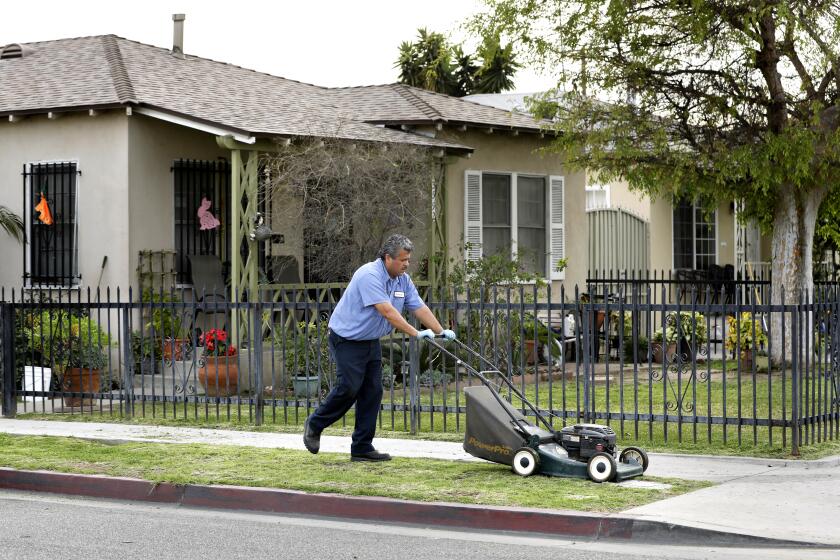Editorial: Put the brakes on L.A.’s all-electric bus plan? No way

When Southern California’s biggest transit agency adopted plans six years ago to make its entire fleet of buses pollution-free by 2030, it was a big step forward for local action on climate and air quality.
But now, Metro wants to unceremoniously move the goalpost. The agency’s staff has proposed delaying the goal by five years, to 2035, saying problems with grid and charging infrastructure, vehicle costs, range and other obstacles will make electrifying its fleet of more than 2,000 buses too difficult to accomplish within seven years.
The proposal, scheduled to be discussed at a public board meeting Thursday, is listed on the agenda under “receive and file,” meaning the Metro staff wants to dial back a key climate goal without so much as a vote.
No way. Metro board members should reject this proposal and stick with the 2030 target, not only because of the urgency of slashing health-damaging air pollution but because it would send a bad message to the community and a burgeoning zero-emission manufacturing industry.
California’s commitment to spend $67 million to clean toxic Exide parkways is good. But the Newsom administration and Legislature need a cleanup done well.
Weakening this important goal seven years before the deadline is shortsighted and premature. Environmental pledges shouldn’t be cast aside lightly, and certainly not just because they seem difficult or even unlikely to be met. What would this move signal about Southern California leaders’ resolve in confronting the climate crisis? And what precedent would it set for other ambitious pledges, like L.A.’s targets for getting 100% of its electricity from carbon-free sources and having a zero-emission port complex by 2035?
County Supervisor Janice Hahn, a member of the Metro board, agrees that postponing the 2030 plan would be a mistake, saying in a statement that “the zero-emissions goals we set can’t be empty promises.”
“Our residents deserve better than five more years of buses polluting the air in their neighborhoods and contributing to greenhouse gas emissions,” Hahn added. “The technology exists, and we should be acting with urgency to make that switch for the sake of our residents.”
Metro staff declined to answer questions about the proposal, saying through a spokesperson that they wanted to wait until after the board meeting to comment.
New York just became the first state to ban gas hookups from new buildings to fight climate change and air pollution. What’s preventing California from doing the same?
A report produced by staff to justify the slowdown said that the zero-emission bus industry “is still evolving and not sufficiently mature to allow for full implementation by 2030 without risk to service.” It highlights a variety of obstacles to full fleet electrification by 2030, including “costs, performance, electrical grid capacity, supply chain and utilities’ lead times, and market availability.”
Some of the necessary grid upgrades could take five to seven years to complete, the report notes. Pushing the goal to 2035 would allow “grid capacity to develop and technology to mature,” the Metro staff wrote.
These may be significant obstacles, but they don’t add up to a good reason to lower expectations and prolong dependence on fossil fuels.
Six years after adopting its zero-emission plans, Metro has made important investments but not a huge amount of progress in electrifying its bus fleet, which remains almost entirely powered by natural gas, a polluting fossil fuel. To date, the agency has ordered 145 battery-electric buses and received 50. Additional deliveries aren’t expected until 2026.
There are still several years to pick up the pace. And there’s a lot of potential to do so, especially given how dramatically federal climate policy has changed since this plan was adopted in 2017, when Donald Trump was president.
Under President Biden there has been a massive commitment of federal climate money from the Inflation Reduction Act and the Infrastructure Investment and Jobs Act. That includes billions in grant funding to help transit agencies buy emissions-free buses and charging equipment over the next few years — more than six times more than what was available in previous years. Metro has received more than $100 million from those grants, and a demonstration of continued leadership with the 2030 zero-emission target would bolster its argument for additional funds — on a timeline that matches the five-year rollout of the money.
When the Los Angeles Metropolitan Transportation Authority retired its last diesel-powered bus in 2011, it became the first major transit agency in the nation to completely switch its fleet to alternative-fuel technologies, demonstrating in the years that followed that buses running on cleaner energy could be both reliable and affordable.
This proposal is also an early test of the environmental leadership of Mayor Karen Bass, who sits on the Metro board. The 2030 zero-emission fleet goal is included in L.A.’s Green New Deal, the climate plan established under former Mayor Eric Garcetti that Bass has said she will continue to implement.
Bass’ office said she is reviewing the proposal. She and other board members should put the matter to a vote and show the public where they stand. Southern Californians should be concerned if the ambitious climate goals leaders voted to adopt, to great fanfare, can be effectively disregarded by administrative fiat.
State rules already require all transit agencies to operate emissions-free bus fleets by 2040. But L.A. has good reason to be more ambitious, and not just because we breathe the nation’s worst smog. Metro’s 2017 plan said the zero-emission goal, combined with $1 billion in spending on new buses, “can make Los Angeles the central marketplace for new electric bus technology,” with well-paying manufacturing jobs. A weaker goal makes the idea of creating local manufacturing jobs, like those at the BYD electric bus factory in Lancaster, less plausible.
The most responsible course of action, economically and environmentally, is to leave the goal unchanged and work as hard as possible to achieve it. Leaders should consider adding interim benchmarks to put them on the right track over next few years, as environmental and labor groups have suggested, knowing they may still fall short.
That’s how targets should work, especially when it comes to avoiding worsening heat waves, wildfires, air pollution and countless other ravages of climate change. Time is a luxury we just don’t have.
More to Read
A cure for the common opinion
Get thought-provoking perspectives with our weekly newsletter.
You may occasionally receive promotional content from the Los Angeles Times.












